Selecting the Best Vegetables for Greenhouse Growth


Intro
Growing vegetables in a greenhouse is not merely a trend. It offers tangible advantages such as better yields and enhanced quality of crops. The controlled environment facilitates optimal growth conditions, making it a favored method for many gardeners, from novices to experts.
Types of Vegetables Suitable for Greenhouse Cultivation
Selecting the right vegetables starts with understanding the categories that thrive in a greenhouse setting. You can categorically arrange vegetables into several groups:
- Leafy Greens: These include lettuce, spinach, and kale, which typically require cooler temperatures.
- Root Vegetables: Carrots, radishes, and beets are suitable, lthough they may need deeper soil to develop properly.
- Fruit-Bearing Plants: Tomatoes, peppers, and cucumbers flourish in warm conditions and are ideal choices for greenhouse gardening.
Factors Influencing Vegetable Selection
Choosing the right vegetable goes beyond personal preference. Various elements dictate what will grow best in a greenhouse:
- Light Requirements: Different vegetables need varying light levels. Some may perform better when exposed to full sunlight, while others might require partial shade.
- Temperature Control: Greenhouses allow for temperature regulation. Knowing the temperature preferences of your selected vegetables is vital.
- Humidity Levels: Some plants thrive in humid environments, while others prefer drier conditions. Adjusting humidity with proper ventilation and watering techniques can significantly impact growth.
- Soil Type: Soil quality and type also affect growth. Use well-draining soil with the right pH balance for the vegetables being cultivated.
Optimal Growing Conditions
To ensure successful greenhouse gardening, several conditions should be optimized:
- Continuous Monitoring: Regular checks on temperature and humidity levels aid in maintaining a balanced environment.
- Adequate Lighting: Supplementing natural light with grow lights can help achieve desired conditions, especially during shorter days.
- Air Circulation: Proper ventilation prevents issues like mold and helps to regulate temperature.
Pest Management Strategies
An effective pest management strategy is essential for any greenhouse gardener. Several methods can be employed:
- Biological Control: Introducing beneficial insects like ladybugs can help manage pest populations naturally.
- Companion Planting: Certain plants can repel pests when grown alongside more vulnerable plants.
- Regular Monitoring: Keep a close eye on plants for signs of infestation. Prompt action is crucial to minimize damage.
Culmination
Prolusion to Greenhouse Gardening
Greenhouse gardening holds a pivotal position in the realm of modern agriculture. It allows gardeners to extend their growing season, even in regions with harsh climates. This is vital for anyone looking to maximize crop yield and variety. By controlling the environment, a greenhouse facilitates the growth of a wide range of vegetables that might otherwise struggle outside. Understanding the basics of greenhouse gardening sets the foundation for selecting vegetables that thrive in such settings.
Definition and Purpose of a Greenhouse
A greenhouse is essentially a structure designed to create an environment optimal for plant growth. Typically made of transparent materials, it enables sunlight to enter while trapping heat. This controlled environment is essential for several reasons:
- It regulates temperature and humidity, protecting plants from extreme weather.
- It creates a barrier against pests and diseases, reducing risks to crops.
- It can provide supplemental lighting, enabling photosynthesis even on cloudy days.
The purpose of a greenhouse extends beyond mere cultivation. It acts as an experimental ground for plant enthusiasts and a vital tool for commercial agricultural enterprises, allowing for local produce all year long.
History and Evolution of Greenhouses
The concept of the greenhouse dates back several centuries. The earliest greenhouses were quite rudimentary. Roman Emperor Tiberius, for example, had a structure built in 30 AD that was akin to modern greenhouses. Over time, the designs evolved from simple frames covered in cloth or glass to the sophisticated structures we see today.
In the 16th century, glass became more accessible, which significantly enhanced greenhouse design. By the 19th century, advancements in engineering introduced iron and glass structures to the public. Today, we see greenhouses made of a variety of materials and with diverse designs.
The evolution continues as technology advances. Modern greenhouses often incorporate automated climate controls and advanced growing systems. This progression not only enhances the efficiency of vegetable production but also caters to the growing demand for year-round food sources.
Benefits of Growing Vegetables in a Greenhouse
Greenhouse gardening offers numerous advantages, especially when it comes to vegetable cultivation. This section highlights the significance of growing vegetables in a greenhouse, touching on the various benefits that are intrinsic to such a controlled environment. Understanding these benefits can give gardeners insights into making informed decisions, which in turn leads to healthier plants and more abundant harvests.
Extended Growing Seasons
One of the primary benefits of greenhouse gardening is the extension of the growing season. In a greenhouse, temperatures can be regulated, allowing gardeners to start planting earlier in the spring and continue harvesting later into the fall or even winter. This capability is essential for regions with shorter growing seasons or harsh climates.
In more detail, a greenhouse traps heat from sunlight, providing warmer air and soil conditions. This protection mitigates the effects of frost and extreme weather. As a result, gardeners can grow a wider variety of vegetables, even those that would typically not thrive in specific climates. For instance, warm-season crops like tomatoes can be grown year-round with the right setup in a greenhouse.
"A controlled environment enables optimal growth, enhancing both quality and yield of crops."
Controlled Environment for Optimal Growth
A greenhouse provides a unique setting that allows for meticulous control over growth conditions. Factors such as temperature, humidity, and light can be adjusted to meet the needs of various vegetables. This customization leads to improved plant health and productivity.
For example, many plants require specific light conditions. In a greenhouse, supplemental lighting can be utilized to ensure that plants receive sufficient light, even in the winter months. Humidity can also be managed, preventing issues like wilting or diseases caused by excessive moisture.
Controlled environments also reduce the stress on plants. With minimized fluctuations in temperature and humidity, crops can focus their energy on growth instead of survival. This ultimately results in healthier plants and a more fruitful harvest.
Protection from Pests and Diseases
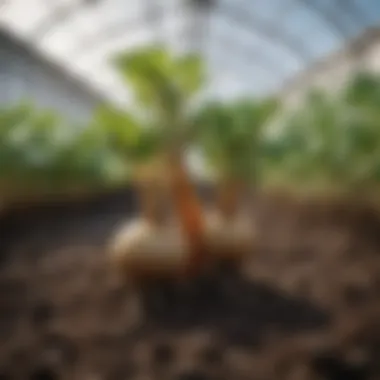
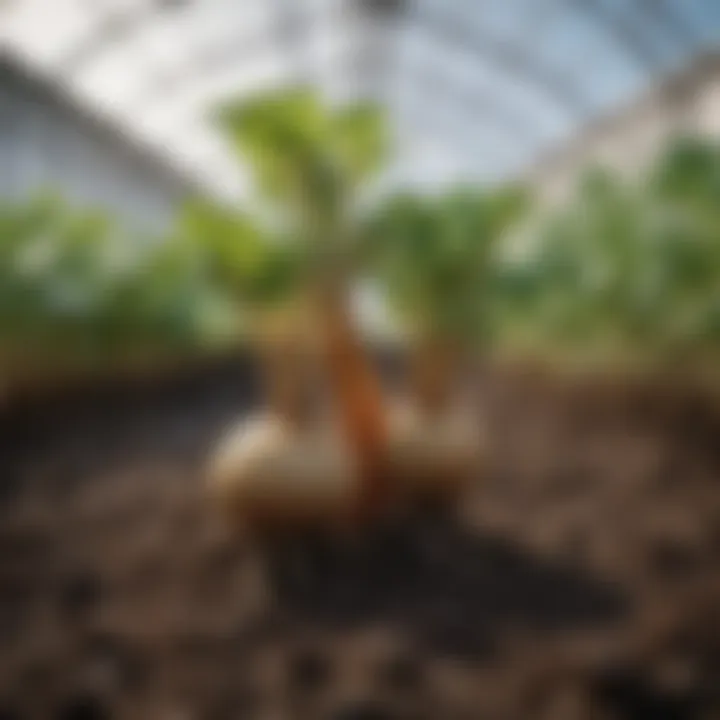
Greenhouses serve as a barrier against various pests and diseases that can decimate conventional garden crops. Closing the structure limits access for unwanted insects and animals, thereby reducing the need for chemical pesticides.
In addition, a greenhouse can help create an environment where beneficial insects thrive while keeping harmful pests at bay. For example, ladybugs can control aphid populations naturally within a greenhouse. The controlled space allows for easier monitoring of plants for disease symptoms, enabling quicker intervention if necessary.
Ultimately, this protection can lead to higher quality produce, free from the chemical residues often found in mass-produced vegetables. A focus on integrated pest management tactics within the greenhouse environment will ensure long-term sustainability and health of crops.
Factors Affecting Vegetable Growth in a Greenhouse
Selecting the right vegetables for greenhouse cultivation involves understanding various factors that can affect their growth. Recognizing these factors is key to optimizing the growing environment, which can significantly influence both the quality and yield of the crops. When vegetables thrive in a controlled setting, the results can be rewarding. Each element, such as light, temperature, and humidity, works together to create the ideal conditions necessary for growth. Focusing on these aspects allows growers to make informed decisions, improving their chances of successful harvests.
Light Requirements
Light is one of the most critical factors for plant growth in a greenhouse. Each vegetable variety has specific light needs. For instance, leafy greens like spinach and kale thrive with moderate light, while fruiting vegetables such as tomatoes require bright light to produce effectively. Insufficient light levels can lead to weak plants and poor yields.
- Understanding Light Types: Natural light varies with seasons, necessitating the use of supplemental lighting in darker months.
- Light Duration: Most vegetables benefit from 12-16 hours of light daily. Maintaining this schedule can maximize photosynthesis, leading to lush and vigorous growth.
- Light Quality: The spectrum of light impacts plant development. Full-spectrum lights are often best, mimicking sunlight and fostering healthy growth.
For serious growers, investing in a light meter can help measure light intensity and adjust conditions as needed.
Temperature Control
Temperature control is vital in a greenhouse setting. Temperature affects germination, growth rates, and crop quality. Each vegetable has an optimal temperature range that must be maintained for best results.
- Daytime and Nighttime Temperatures: Generally, daytime temperatures should be set between 70°F to 85°F, while nighttime temperatures should drop to about 60°F to 70°F. This fluctuation mimics natural conditions and stimulates growth.
- Seasonal Adjustments: In winter, heating systems may be necessary to maintain warmth, while shade materials can help prevent overheating in summer.
- Monitoring Systems: Installing thermostats and temperature sensors enables growers to track conditions and make adjustments swiftly.
Keeping temperature within the optimal range not only boosts plant health but also enhances the overall quality of the crops.
Humidity Levels
Humidity plays a crucial role in plant transpiration and nutrient uptake. It also impacts plant health and susceptibility to diseases.
- Ideal Humidity Range: Generally, humidity levels between 50% to 70% are considered optimal for most vegetables. Too high or too low can lead to problems.
- Managing Humidity: In a greenhouse, maintaining the right humidity may require tools like humidifiers or dehumidifiers. Proper ventilation is equally crucial to facilitate air circulation and prevent moisture buildup.
- Signs of Imbalance: Growers should be mindful of symptoms indicating humidity stress, such as wilting leaves or the presence of mold.
Types of Vegetables to Grow
Selecting the right vegetables for greenhouse cultivation is crucial for maximizing yield and achieving quality. The controlled environment allows for the growth of various types of plants, enabling gardeners to choose those that benefit from the unique conditions of a greenhouse. Vegetables can be broadly classified into leafy greens, root vegetables, and fruiting vegetables, each with their distinct characteristics and requirements.
Leafy Greens
Leafy greens thrive in greenhouse settings as they require a stable climate. These vegetables benefit from consistent temperatures and humidity, which greenhouses can provide. Notably, they grow fast, allowing for multiple harvests throughout the year. Here, we focus on three popular options.
Spinach
Spinach is a highly nutritious leafy green that grows quickly and extensively in greenhouses. Its ability to grow in varied conditions makes it a flexible choice for gardeners. The key characteristic of spinach is its rich content of vitamins A, C, and K, along with iron.
The unique feature of spinach is the capacity for production in both cool and warm climates. It has short growing cycles, so it can be harvested multiple times per year, which is beneficial for maximizing space in the greenhouse.
However, spinach can be susceptible to bolting in warm weather. It is important to maintain optimal temperature conditions for effective growth.
Kale
Kale has gained popularity for its health benefits and ease of cultivation. It remains a practical option for greenhouse gardening due to its cold-weather tolerance. A key characteristic of kale is its ability to enhance nutrient content when exposed to light, contributing to its acclaimed health benefits.
Unlike many other leafy greens, kale can withstand frost, which means that it can extend the harvest period into the colder months. The unique feature of kale is its diverse varieties, each with unique flavors and textures.
Nevertheless, the robust nature of kale means it can outgrow neighboring plants quickly. Effective spacing and careful planning are necessary to manage growth in a confined space.
Swiss Chard
Swiss chard is another excellent choice for greenhouse cultivation, renowned for its colorful stalks and leafy tops. Its rich nutrient profile, including fiber and various vitamins, makes it a valuable addition to any garden. The key characteristic of Swiss chard is its adaptability to soil types and conditions.
The vibrant colors of its stems can add an aesthetic appeal to your greenhouse. Swiss chard also offers a prolonged growing season and is less susceptible to pest damage.
However, it’s sensitive to overwatering, so gardeners must ensure proper drainage and moisture levels to prevent root rot.
Root Vegetables
Root vegetables are also suitable for greenhouse environments because they require stable soil temperatures and conditions. They can provide growers with diverse options that contribute to a balanced diet. The following three root vegetables are ideal candidates for cultivation.
Carrots
Carrots are a staple in many gardens and thrive in greenhouse settings due to their preference for well-drained, loamy soil. The key characteristic of carrots is their ability to attractively blend in with other crops due to their underground growth.
The unique aspect of carrots is the variety of colors they come in, from orange to purple. This diversity not only enhances visual appeal but also allows for a broader range of nutrients. Carrots can be grown from seed to harvest in about 70 to 80 days, depending on the variety.
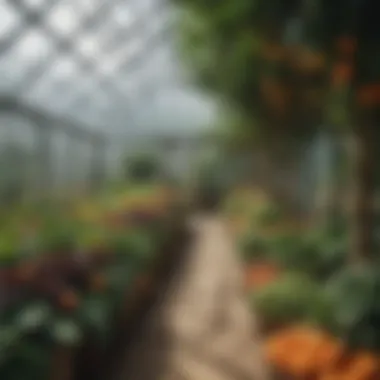
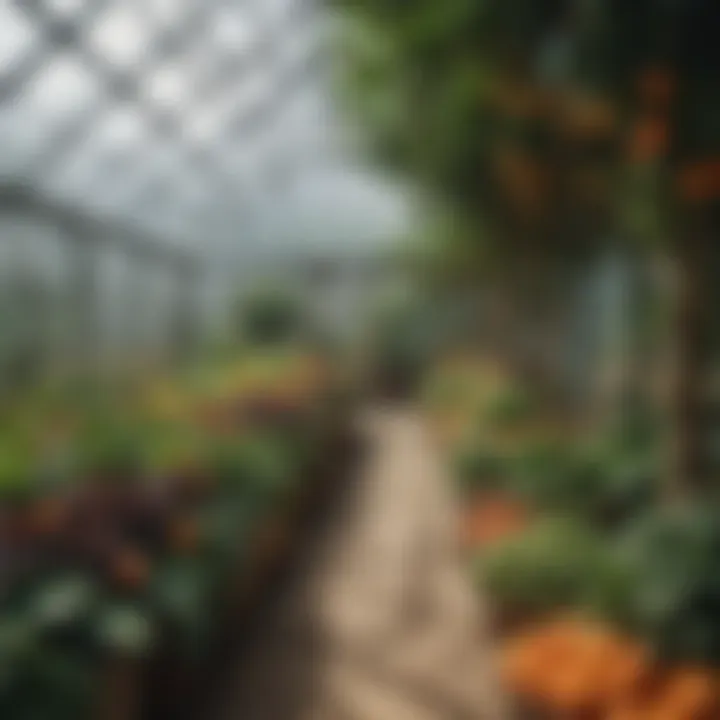
They require careful spacing to develop properly, as overcrowding can lead to undesirable shapes and smaller yields.
Beets
Beets are another worthwhile option. They flourish in cooler greenhouse conditions and have robust growth cycles. The key characteristic of beets is their dual-purpose use, as both roots and leafy greens are edible.
The unique feature of beets is their rich color, which comes from betalains, providing potential health benefits. They can be harvested throughout the season, which makes them a valuable option for greenhouse gardening.
However, beets can attract some pests, so monitoring is necessary to mitigate potential issues.
Radishes
Radishes grow rapidly, making them an excellent choice for quick returns on your greenhouse investment. The key characteristic of radishes is their fast-growing nature, often ready for harvest in as little as three weeks.
The unique quality of radishes is their peppery flavor, which can enhance various dishes. They can be grown in spaced-out configurations, which helps other plants benefit from the nutrient-rich soil they create as they mature.
Nevertheless, radishes can become woody if left too long in the ground, so timely harvesting is essential to maintaining quality.
Fruiting Vegetables
Fruiting vegetables can greatly benefit a greenhouse, as they require warm weather and consistent sunlight, conditions that greenhouses provide effectively. The following three types are particularly recommended for greenhouse cultivation.
Tomatoes
Tomatoes represent one of the most popular greenhouse crops, known for their versatility in cooking and nutrition. The key characteristic of tomatoes is their requirement for warmth and light to flourish. In greenhouses, gardeners can control these conditions precisely, yielding high-quality produce.
The unique feature of tomatoes is their many varieties, from small cherry tomatoes to large beefsteaks. This diversity allows growers to choose types based on space, taste, and intended use.
However, tomatoes can be prone to diseases like blight, so proper air circulation and care are necessary to prevent potential problems.
Cucumbers
Cucumbers thrive in warm, humid conditions, making them ideal for greenhouse settings. Their key characteristic is their climbing nature, which allows them to utilize vertical space in the greenhouse efficiently.
The unique quality of cucumbers is their refreshing taste, making them a favorite in salads. Growers can implement trellising methods to maximize yield while saving soil space.
However, cucumbers require regular watering and can suffer from pests if not monitored closely, complicating their cultivation without proper management.
Peppers
Peppers, including bell and hot varieties, flourish in warm conditions. They are colorful and add a flavorful touch to many dishes, thus having a key characteristic of providing culinary variety.
The unique feature of peppers is their adaptability to different growth conditions, flourishing in slightly cooler settings compared to other fruiting vegetables. This flexibility allows for a more versatile growing experience.
Nonetheless, peppers can be susceptible to blossom drop if temperatures fluctuate excessively, meaning growers must maintain stable conditions for optimal production.
In summary, selecting the right types of vegetables not only enhances yield but also enriches the gardening experience in a greenhouse. Consider each plant's specific characteristics and requirements to maximize space and resources.
Practical Considerations for Greenhouse Gardening
Practical considerations play an essential role in the success of greenhouse gardening. These factors affect how effectively vegetables can be grown in this controlled environment. Understanding the unique requirements of soil, water, and nutrients can drastically influence yield and quality. Choosing the right strategies in these areas will contribute significantly to an overall successful cultivation process.
Soil Selection and Preparation
Soil is the foundational element for any garden, including greenhouses. Selecting the right soil type is critical for achieving optimum vegetable growth. Greenhouse soil should be well-aerated, rich in organic matter, and capable of retaining moisture without waterlogging.
Common options for greenhouse soil include a blend of potting soil, compost, and perlite or vermiculite. Mixing these components can enhance drainage and provide the necessary nutrients for various vegetables. Soil pH is also an important consideration. Most vegetables thrive in a pH range of 6.0 to 7.0. Testing soil pH and amending it accordingly will ensure an ideal environment for plant roots.
Preparation of the soil involves tilling and aerating it to improve structure and facilitate root growth. Adding organic fertilizers during this stage can provide a nutrient boost. Ensuring that the soil is free from pests and diseases is equally vital. It may be useful to sterilize soil before use or source soil from a reputable supplier.
Watering Techniques and Systems
Watering techniques directly impact the health of vegetables in a greenhouse. Proper moisture levels promote healthy growth and prevent common issues like root rot or wilting. One popular method is drip irrigation, which allows for precision watering. It delivers water directly to the plant's roots, minimizing waste and reducing water-related diseases.
Alternatively, overhead watering systems can be used, but it is crucial to avoid wetting the foliage excessively to prevent diseases. Automated systems can be considered for consistency. Using a rain gauge or moisture sensors can help gauge how much water is needed, thus optimizing water use.
The frequency of watering must also be monitored and adjusted based on various factors such as plant type, growth stage, and environmental conditions. Observing the soil's moisture level makes it easier to decide when to water, ensuring that your plants have adequate hydration without over-saturating.
Fertilization Strategies
Fertilization strategies are vital for maintaining healthy vegetable growth in greenhouse settings. It's a way to replace nutrients that plants use during their development. Different plants have specific nutrient requirements, including nitrogen, phosphorus, and potassium, among others. Selecting the appropriate fertilizer involves understanding these needs.
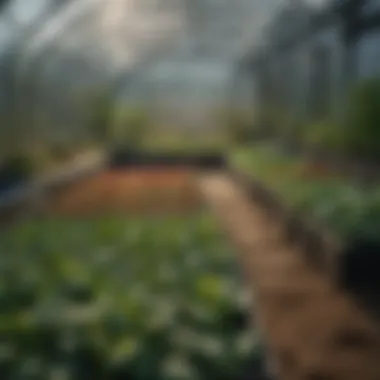

Using a combination of slow-release fertilizers and liquid feed can be effective. Slow-release options provide nutrients over an extended period, while liquid fertilizers can be administered more frequently for immediate nutrient uptake. Conducting soil tests regularly can help determine nutrient availability and inform fertilization choices.
Careful timing and application are also essential. Fertilizers should be applied during critical growth phases, such as flowering and fruiting, to maximize their effectiveness. Over-fertilization should be avoided, as it can lead to nutrient imbalances and poor plant performance.
Effective management of soil, water, and nutrients will not only enhance growing conditions but also significantly affect the overall productivity of your greenhouse.
Understanding and implementing practical considerations can lead to more fruitful greenhouse gardening. These key areas of focus will ensure that your vegetable plants thrive in their environment.
Crop Rotation and Companion Planting
Crop rotation and companion planting are essential practices in greenhouse gardening. These techniques not only improve soil health but also enhance plant growth. They contribute to pest management and disease prevention, maximizing the benefits of greenhouse cultivation. Understanding these concepts is crucial for anyone looking to optimize their vegetable production.
Importance of Crop Rotation
Crop rotation refers to the systematic alternation of different crops on the same land over time. This practice has several important advantages. First, it helps to maintain soil fertility. Different plants have varying nutrient needs. By rotating crops, the soil can replenish nutrients that specific crops may deplete.
Second, crop rotation reduces the buildup of pests and diseases. Many pests tend to specialize in particular plants. Changing crops disrupts their life cycle, making it harder for them to establish a habitat. This minimizes the reliance on chemical interventions.
Moreover, crop rotation can lead to improved yields. When the same vegetable is grown continuously, soil health can decline, affecting plant growth. Rotating crops encourages a more balanced ecosystem within the soil, promoting better growth.
Benefits of Companion Planting
Companion planting involves growing different plants together in a way that benefits one or both. This method can enhance flavor, protect against pests, and even improve growth rates. Companion planting offers several notable benefits for greenhouse gardeners.
One key benefit is natural pest control. Certain plants can repel pests or attract beneficial insects. For example, planting marigolds with vegetables can deter aphids and nematodes. This helps create a balanced ecosystem with fewer pests.
Additionally, some plants have complementary growth habits. For instance, planting beans with corn can be beneficial. Beans fix nitrogen in the soil, which corn utilizes for its growth. This mutual relationship enhances the productivity of both plants.
In greenhouse settings, careful selection of companion plants can maximize space and resources. Utilizing vertical space allows for diverse planting, creating more produce in limited areas.
Pest and Disease Management in Greenhouses
Effective pest and disease management is crucial for any greenhouse operation. This section sheds light on the significance of addressing these concerns. In a greenhouse, the controlled environment fosters not only the ideal growth conditions for crops but also can inadvertently provide a sanctuary for pests and pathogens. Understanding the balance between enabling plant growth and protecting them from these threats is essential for achieving maximum yield and quality.
The advantages of managing pests and diseases in a greenhouse include:
- Enhanced Crop Health: Regular monitoring and management strategies lead to healthier plants, which translates to better yields.
- Reduced Chemical Use: Effective pest management helps in minimizing the need for chemical pesticides, thus supporting organic practices and sustainability.
- Increased Knowledge: Understanding pest behaviors improves the skill set of growers, leading to more informed decisions.
- Improved Economic Return: Healthy crops result in a better market value, ensuring that the investment in greenhouse cultivation pays off.
Common Pests in Greenhouses
Pests can cause significant damage to vegetables grown in a greenhouse. Common invaders include aphids, spider mites, whiteflies, and thrips. Each of these pests has unique characteristics and can affect various plant types differently:
- Aphids: Small, soft-bodied insects that suck plant sap. They tend to reproduce quickly, often leading to large infestations.
- Spider Mites: Not true insects, these are tiny arachnids that can cause leaf discoloration and webbing on plants. They thrive in warm, dry conditions.
- Whiteflies: These small, winged insects feed on the underside of leaves. They can also transmit plant viruses.
- Thrips: Tiny and slender, these pests can cause stippling damage to leaves, affecting plant health.
It is vital to identify these pests early on to prevent further spread and damage. Regular scouting and use of sticky traps can help in monitoring their presence effectively.
Preventive Measures and Treatments
Preventive measures are the frontline defense in pest and disease management. Implementing integrated pest management (IPM) strategies is advisable. These can include:
- Cultural Practices: Rotate crops and maintain cleanliness in the greenhouse to reduce pest populations.
- Biological Control: Encourage beneficial insects, like ladybugs and lacewings, that prey on common pests.
- Mechanical Control: Use barriers such as insect netting to keep pests out and limit their access to plants.
In case of an infestation, various treatment options are available:
- Insecticidal Soaps: These are effective against soft-bodied insects like aphids and should be applied directly onto pests.
- Neem Oil: Derived from the seeds of the neem tree, this oil can disrupt the life cycles of pests.
- Pesticidal Dusts: For specific pests, these can be effective. However, follow label instructions closely.
Regular monitoring and timely intervention can significantly reduce the impact of pests and diseases.
Being proactive rather than reactive will save time and resources while ensuring a productive greenhouse environment. All growers can benefit from developing a thorough understanding and approach to pest and disease management.
Ending
In any discussion about greenhouse cultivation, the conclusion serves as a vital synthesis of the preceding topics. It is the moment where all the insights and knowledge gained throughout the article come together. Emphasizing the core elements that enable successful vegetable gardening in a greenhouse, this section crystallizes understanding for readers eager to enhance their gardening practices.
One of the key points to grasp is the significance of selecting the right vegetables. An awareness of all recommended types, such as leafy greens, root vegetables, and fruiting vegetables, is essential. Each category has distinct requirements and benefits that can directly affect yield and growth quality. For instance, leafy greens usually thrive in cooler temperatures while fruiting vegetables may need warmer conditions to produce successfully.
Moreover, the ability to manage challenges like pests and diseases through informed choices adds another layer of importance to the conclusion. By applying the discussed pest management strategies, one can prevent significant losses and ensure a healthy greenhouse environment.
Ultimately, the conclusion reinforces that understanding both practical considerations and plant requirements is essential for a successful greenhouse operation. This knowledge equips growers to make informed choices, resulting in a fruitful gardening experience.
Recap of Key Points
- Understanding the vegetable types: Knowing which vegetables thrive in a greenhouse context helps in planning.
- Management of pests and diseases: Effective strategies are necessary to maintain the health of plants and improve yield.
- Environmental conditions: Controlling light, temperature, and humidity contributes greatly to optimal growth.
- Practical considerations: Proper soil preparation, watering techniques, and fertilization strategies are crucial for success.
Final Thoughts on Greenhouse Gardening
Greenhouse gardening opens up immense possibilities for vegetable cultivation. As discussed, understanding the environmental factors and choosing suitable vegetables plays a crucial role in this process. Furthermore, the benefits of having a controlled growth environment are substantial. Effective management of pests and diseases ensures not only the health of plants but also maximizes yield.
As you reflect on this journey through greenhouse cultivation, consider how you apply the insights gained. The methodologies discussed are not just theory; they are practices that can transform your gardening experience. Embrace the opportunity to explore a vast array of vegetables and cultivate a biophilic space that thrives under your care. In weighing all these aspects, greenhouse gardening indeed offers a rewarding and productive venture for enthusiasts and novices alike.







